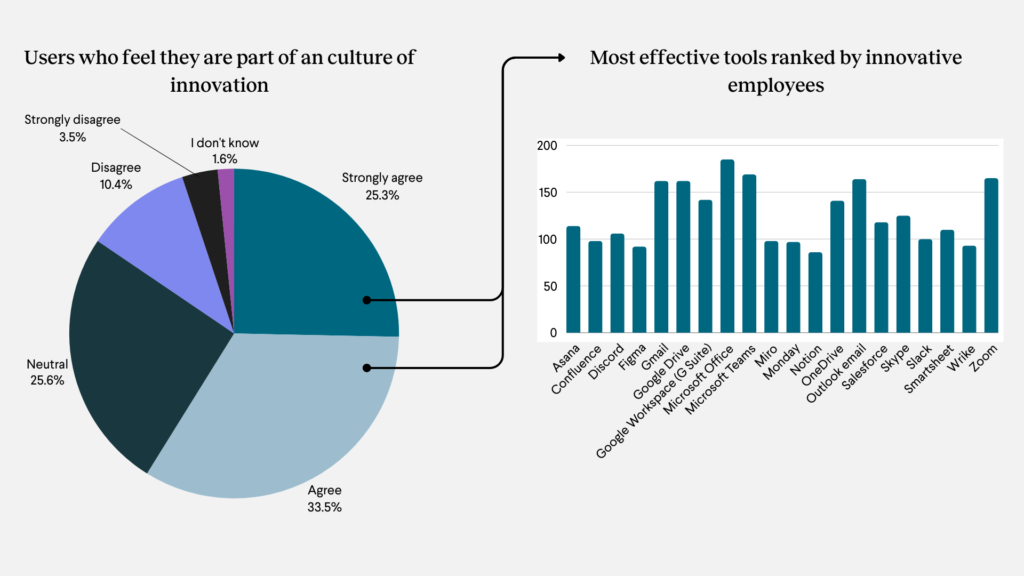Thanks to workplace technologies, distributed work arrangements have existed for decades in large enterprises. Given the massive push toward remote and hybrid work in recent years, companies of all sizes can now also benefit from these arrangements.
The Conference Board reports that just 4% of CEOs worldwide will prioritize returning to the office in 2024, reinforcing the demand for flexible work arrangements. The key now is for organizations to sift through an ever-evolving landscape of tools and technologies that each promises to be the cure-all for the potential hurdles of remote and hybrid work.
To understand the current state of hybrid and remote work —and uncover which tools are actually worth the investment —we conducted our inaugural Remote/Hybrid/Distributed Work Index by surveying hundreds of workers in the U.S.
The findings provide clear insights into which technologies are most effective for enabling team engagement and innovation. Let’s dig into a few highlights.
Technologies that Power Remote Collaboration
Our research reinforced that workers at hybrid and fully remote companies overwhelmingly feel more engaged and innovative compared to working in a full-time office setting.
When we looked at how these employees ranked the most effective workplace tools, there were several clear distinctions between which tools enable engagement and which foster innovation.
Remote Work Tools for Engaged Employees
Our research found that 39.8% of distributed workers agree, and 26.4% strongly agree, that they are more engaged in a remote and hybrid setting. Only 12.3% disagreed —and those workers may benefit from new or improved tooling.
We asked these engaged employees about the specific tools they think are most effective for powering their distributed workplace. The following are a few of their clear favorites:
- Workplace management suites: Microsoft Office was the top-ranked tool by engaged employees, with Google Drive following closely. Complementary tools, including Gmail, Microsoft Teams, and Outlook email also ranked highly. These rankings reinforce the need for remote and hybrid teams to access, store, and share documents in a centralized place.
- Video conferencing tools: Given the need for more personalized collaboration, it’s no surprise that Zoom is a top favorite, followed by Microsoft Teams and Skype. Regardless of which video conferencing tool your team uses, ensure that you create guidelines around its use to reinforce how team members can collaborate effectively.
- Workplace messaging tools: Microsoft Teams was our research’s highest-ranked instant messaging and collaboration tool. Slack and Discord, however, ranked as the bottom two tools for engaged workers. These rankings could suggest that companies need to encourage engagement on messaging tools more consciously, or that it’s time to transition away from Slack to Teams.

Remote Work Tools to Inspire Innovation
As another lens to examine the best workplace tools for remote and hybrid teams, we asked employees whether they feel they are part of a culture of innovation. From the 58.8% of respondents who agreed or strongly agreed, we asked which workplace tools they found to be most effective.
Notably, the tools achieved a more level baseline than when ranked by workers in engaging cultures. Previously low-ranking tools like Slack and Discord appeared much closer to the middle of the pack than before, with a smaller difference between the top- and bottom-ranked tools.
- Workplace management suites: Microsoft Office was again the top choice from our research, followed by Google Drive.
- Video conferencing tools: Zoom was again a top favorite, with Skype following closely. This data reinforces that video conferencing tools are essential in inspiring innovation, which could be amplified by features that support healthy brainstorming and collaboration.
- Project management tools: The project management tools in our survey as a category were ranked more favorably by innovative organizations than engaged ones. Smartsheet, one of the lowest-ranked tools by engaged employees, surpassed Monday, Miro, and Wrike in this data splice.

Design A Remote-First Workplace
Organizations should prioritize their investments from a remote-first lens to maximize the benefits of any workplace technologies.
Why? Dedicated online workspaces create a central hub for all company knowledge, regardless of whether employees work in an office part of the time. A well-built virtual workspace can foster workplace inclusivity and knowledge retention while enabling analytics and AI capabilities that empower workplace leaders to measure and optimize their team outputs.
If a workplace is built to prioritize the in-person experience, distributed workers will inevitably lack the resources and tools they need to embed in the company and support its mission effectively.
Strategies to Empower Hybrid Teams
Workplace technologies are an integral part of an effective distributed team —but they are just one piece of what helps remote and hybrid workers thrive.
To learn more about overcoming the potential challenges of distributed work and maximizing the opportunities with your remote or hybrid team, download the full Frameable Remote/Hybrid/Distributed Work Index today.

